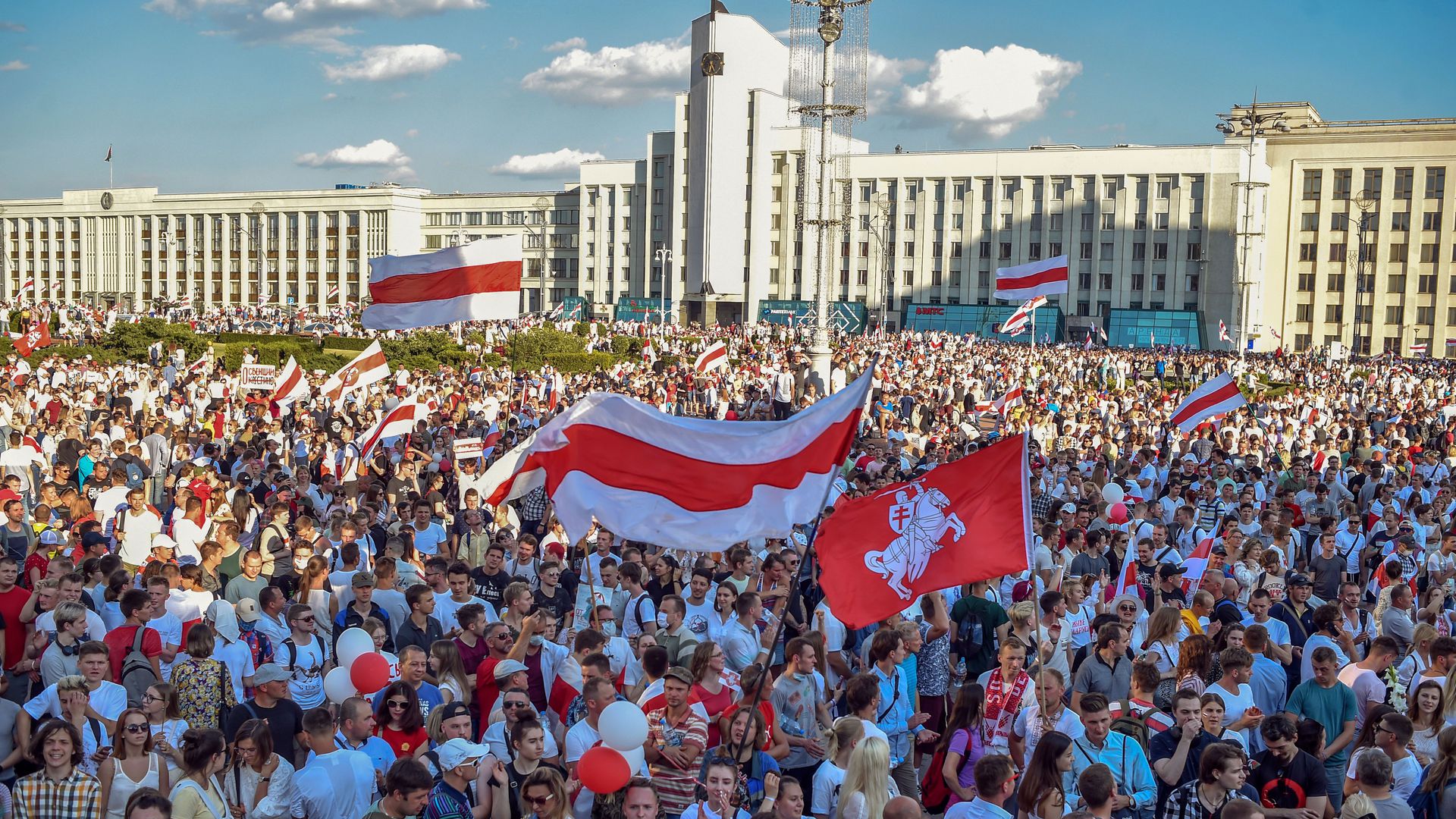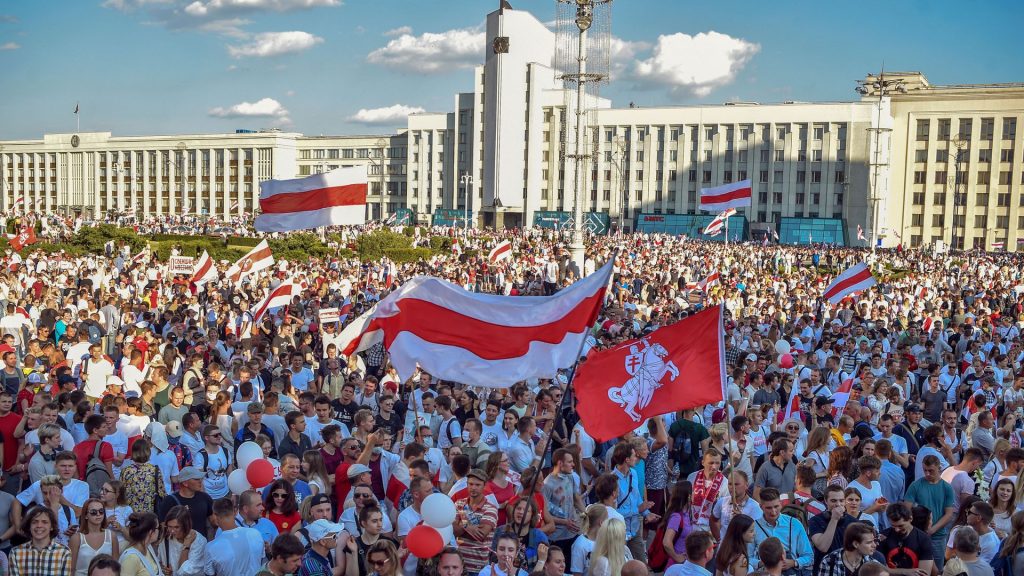The Communist Party’s International Commission has issued a briefing note on the current political crisis in Belarus and its wider international context.
The outcome of the Belarus presidential elections was declared on 9 August. The official results gave Alexander Lukashenko 80 per cent of the vote and Svetlana Tikhanovskaya 10 per cent. The results were recognised by Russia, China, Vietnam, Venezuela, Nicaragua, Armenia and all other former republics of the USSR apart from Georgia, Ukraine and the three Baltic republics. The results were challenged by the opposition, by the EU and the United States. The opposition, claiming victory, immediately set up a Coordination Committee to oversee the transfer of power.
Since the elections there have been regular opposition mobilisations in the main cities of Belarus, involving some workplaces, during which it is reported that a number of demonstrators have been killed or injured by security forces and many arrested. These mobilisations are claimed to involve many thousands. The notes below are intended to provide some background to these events. The main published sources are the 12 August article on the website of the PCF and the features in the Morning Star on 27 August by Petro Symonenko, general secretary of the ukrainian Communist Party, and Kristian Carter on 29 August.
Socio-economic profile
Belarus has a developed industrial economy with a per capita GDP of $16,900 – as against $8,900 in Ukraine, $22,300 in Poland and $23,000 in the Russian Federation. Belarus was the industrially most developed of the Soviet republics and its main industries today are petrochemicals, chemical derivatives, steel, motor manufacturing (buses, cars and heavy industrial work vehicles), potash fertiliser (one of the world’s biggest producers), industrial farming and dairy products. It has always had a strong electronics, IT and software sector strengthened by some more recent developments in electronics in partnership with China. The industrial park in Minsk is largely focused on software production and currently has 700 operating units as part of the Belt and Road initiative. IT now generates up to 6 per cent of GDP based on exports to the EU and the US (estimated to reach 10 per cent by 2023). Belarus’s economic development has been sustained by a highly effective educational system and a strong welfare state. There are 40 doctors per 10,000 of population as against 23 in Poland, 30 in Ukraine, 31 in Latvia and 40 in Russia (and 28 in Britain). Infant mortality is very low at 3.6 per thousand – as against 4.3 in Britain, 4.4 in Poland, 5.2 in Latvia, 6.8 in Russia and 7.8 in Ukraine.
Political and economic developments
Alexander Lukashenko was a member of the State Council of the previous Soviet Republic and opposed the dissolution of the Soviet union. he also opposed subsequent attempts to privatise Belarus’s industrial assets and was elected on this basis as State President in 1995. Lukashenko has sought to maintain economic and political ties with the Russian Federation and Russia remains Belarus’s main market. But the relationship with Russia has, however, been complex and, according to the PCF, on occasion demanded Ukraine’s acquiescence in deals involving Belarus’s energy sector via Russian oligarchs – which Lukashenko refused. This led Lukashenko to seek limited and tactical trading agreements with Western bloc countries, principally Germany. In the current crisis the government has the support of the Communist Party of Belarus. A meeting of the Women’s International Democratic Federation on 29 August condemned any outside intervention and stressed that the future of Belarus must be decided by the people of Belarus and themselves alone.
Trade unions
World Federation of Trade Unions-affiliated Federation of Trade Unions of Belarus (FPB) is the largest trade union centre in the country, organising 30 sectoral unions. The much smaller 9,000 member Belarusian Congress of Democratic Trade unions (BKDP) is the International Trade Union Congress’s affiliate. The International Labour Organisation has criticised the government of Belarus for regulations that prohibit the foreign funding of trade union organisations – regulations that have been used against some BKDP organisations.
Belarus and colour revolutions
Lukashenko’s first direct challenge to the US and NATO was in 1999 when he officially visited Serbia during the NATO bombing campaign, he also refused to back the US invasion of Iraq in 2003. In the run-up to the 2006 presidential election he was opposed by a ‘democratic mobilisation’ mainly orchestrated by an organisation called Otpoor, operating since 2003, under the slogan ‘Yesterday Milosevic, Tomorrow Lukashenko’, and principally funded from the US endowment for Democracy. This attempt was named the ‘Denim Revolution’ – following the 2003 Rose Revolution in Georgia, the 2004 orange Revolution in Ukraine and the 2005 Cedar Revolution in Lebanon. All were in part funded and organised by US government agencies.
There were similar attempts in 2010 and 2015. Lukashenko’s success in thwarting these attempts at regime change has created a ‘defence studies’ literature seeking to draw lessons for future interventions: Stephen GF hill, ‘Preventing a Colour Revolution’, Slavonic and Eastern European Studies, UCL, 2017. On the present occasion considerable support has come from right-wing organisations in Poland, the Baltic Republics and Ukraine. The funding for the ‘democratic’ opposition comes from USaid, the US endowment for Democracy and from the EU (the Council of ministers decision in August spoke of an additional future subvention of 60 million euros). The red and white flags used are the same as those used by the German-backed separatist republic in 1918 and by the Nazi puppet regime in 1943-44.
Popular support for the opposition in 2020
This is on a very significant scale, particularly among the young and appears to have some support in workplaces (although government supporters claim this support is more apparent than real and externally enforced). According to the PCF assessment a significant element in popular dissatisfaction has been triggered by the return to Belarus of up to 600,000 workers previously employed in the Russian Federation after the government there shut down production in face of COVID-19 (the COVID-19 death rate in Belarus itself is low at 7.2 per 100,000 as against 65.1 in Britain).
External agendas
Commentators in the Financial Times over the month of August flagged up the opportunities provided for Western investors by Belarus’s highly skilled technical workforce and its developing IT and engineering industries, the economic benefits this would provide for the EU economy and the advantages of realigning Belarus within the military division of Europe and abandoning the uncertain and risky prospect of any change (or ‘reset of relations’) with Russia.
Henry Foy on 19 August detailed the strengths of the country’s engineering and IT expertise. On 30 August former Ukrainian PM Arseniy Yatsenyuk, in an extensive FT feature, called for full NATO and EU membership to be extended to Ukraine, Georgia and Belarus, for the West to abandon any thought of a ‘reset of relations’ with Russia and instead adopt a ‘forward’ policy to regain control of the Crimea and Eastern Ukraine as well as Belarus. On 31 August the FT called editorially for the EU to take a tougher line on Belarus, to impose sanctions and to do so also on Russia if necessary – and did so while at the same time recognising that the protests appeared to be losing momentum.
Challenge News Desk




